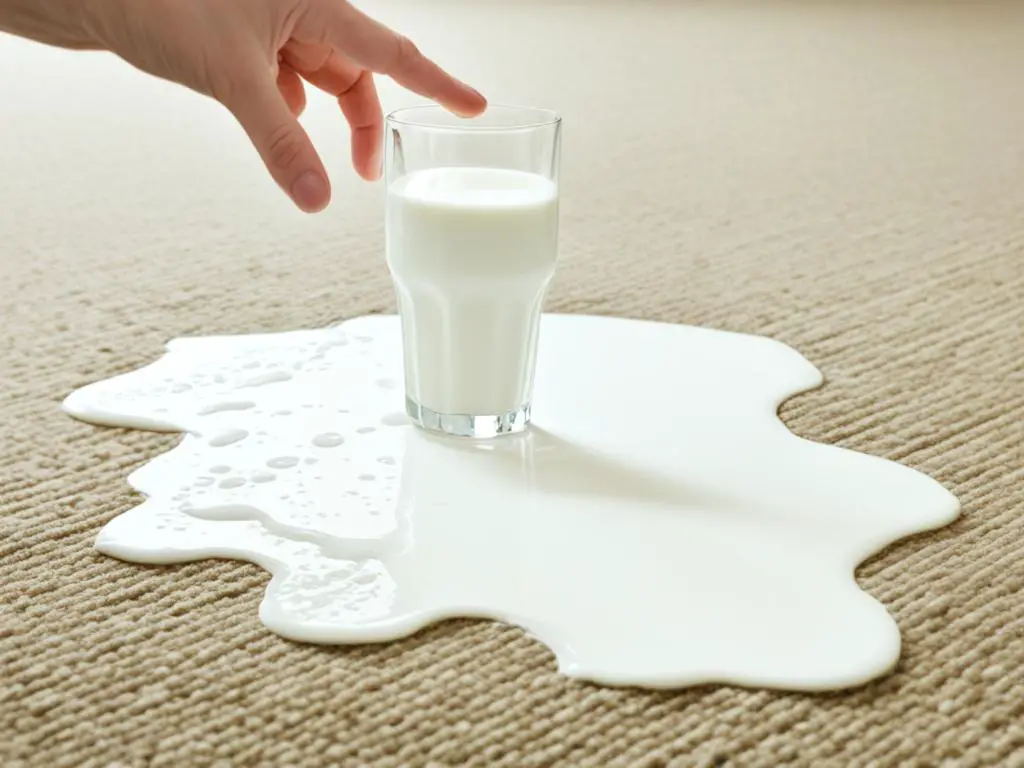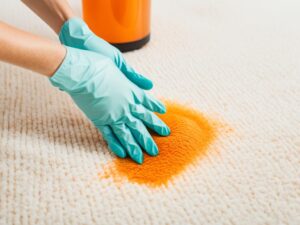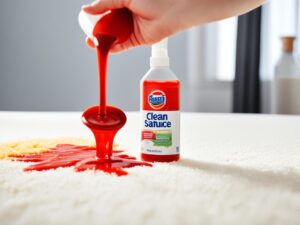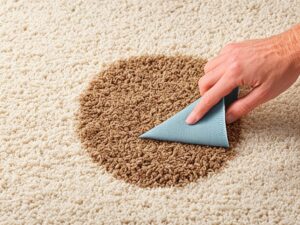When milk spills on your carpet, it can quickly turn sour and cause both odor and staining. To effectively clean up sour milk spills, it’s important to act quickly. Start by blotting the milk with a paper towel or absorbent cloth to remove as much liquid as possible. If the milk has dried, scrape off any residue and then apply a paste of laundry soap. Wash the carpet with a solution of cold water and dish soap, working from the outer edge of the spill towards the center. To remove the sour milk smell, sprinkle baking soda on the affected area and vacuum it up the next day.
Key Takeaways:
- To remove soured milk from your carpet, act quickly and start by blotting the spill to remove excess liquid.
- If the milk has dried, scrape off any residue and apply a paste of laundry soap before washing the area with a solution of cold water and dish soap.
- To eliminate the sour milk smell, sprinkle baking soda on the affected area and vacuum it up the next day.
- Acting promptly and using the right cleaning techniques can help prevent staining and eliminate odor from sour milk spills on your carpet.
- Consider using organic and eco-friendly cleaners as an alternative to commercial carpet cleaners for a safer and more environmentally friendly approach.
Tips for Cleaning Milk Spills on Carpet
When a milk spill occurs on your carpet, it’s important to act quickly to prevent staining and odor. Follow these cleaning tips to effectively remove milk stains and keep your carpet looking fresh and clean.
1. Blot the spill
The first step in cleaning milk spills on carpet is to blot the spill with a paper towel or absorbent cloth. This will help remove as much liquid as possible before it seeps into the carpet fibers.
2. Remove dried residue
If the milk has dried on the carpet, carefully scrape off any residue using a plastic utensil or credit card. Be gentle to avoid damaging the carpet fibers. Once the residue is removed, vacuum the area to get rid of any loose particles.
3. Wash with a solution
Next, wash the carpet with a solution of cold water and dish soap. Mix a few drops of dish soap with cold water and apply the solution to the affected area. Use a clean cloth or sponge to gently scrub the carpet, working from the outer edge of the spill towards the center.
4. Rinse and dry
After scrubbing the carpet, rinse the area with clean water to remove any soapy residue. Blot the carpet with a clean cloth or paper towels to dry it thoroughly. If necessary, repeat the washing and rinsing process to ensure all milk stains are removed.
5. Eliminate sour milk smells
If you notice a lingering sour milk smell on your carpet, sprinkle baking soda on the affected area. Leave the baking soda overnight to absorb the odors, then vacuum it up the next day. This will help freshen up your carpet and eliminate any unpleasant smells.
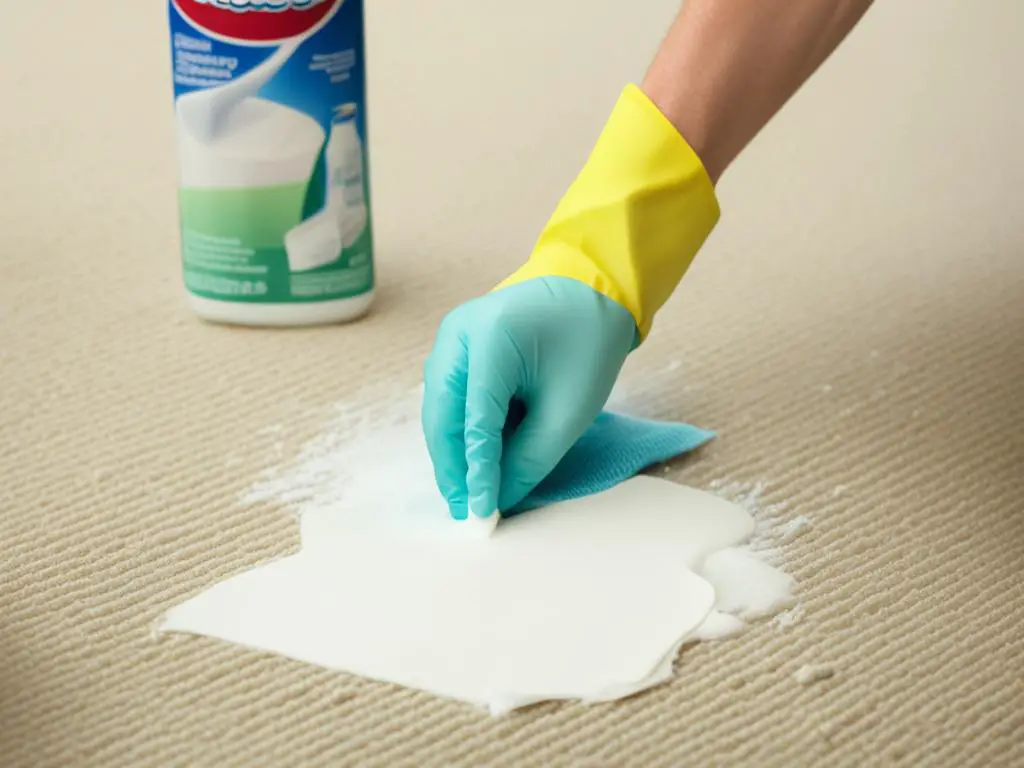
By following these tips, you can effectively clean milk spills on your carpet and maintain a fresh, odor-free environment. Remember to act quickly, remove any residue, and wash and rinse the carpet thoroughly. With proper cleaning techniques, you can keep your carpet looking its best.
Removing Milk Stains from Fabrics
If a milk spill occurs on your upholstered furniture, don’t panic! With a few simple steps, you can effectively remove milk stains and eliminate that sour milk smell from your cherished fabrics.
Here’s a step-by-step guide to help you clean milk spills on upholstery:
- Start by blotting the spill with a paper towel or absorbent cloth to remove as much liquid as possible. Blot gently to avoid spreading the stain.
- If the milk spill has dried, gently scrape off any residue using a tool like a credit card or plastic utensil. Be careful not to damage the fabric.
- Vacuum the area to remove any loose debris or particles.
- Next, take a damp cloth and gently wipe the affected area. This will help remove any remaining milk residue and stains.
- Once you’ve wiped the area, use a clean towel to dry it thoroughly. This will prevent the formation of mold or mildew.
- If you notice a lingering sour milk smell, there’s a simple trick to freshen up your fabric. Sprinkle baking soda generously over the affected area, ensuring full coverage. Let it sit overnight.
- The next day, vacuum up the baking soda, and you’ll be left with a fresh, odor-free fabric.
Remember, it’s crucial to act quickly when dealing with milk spills on upholstery. The longer the milk lingers, the more difficult it becomes to remove stains and odors.
Now, let’s take a moment to admire this adorable image of a fluffy kitty relaxing on a clean and fresh-smelling sofa:
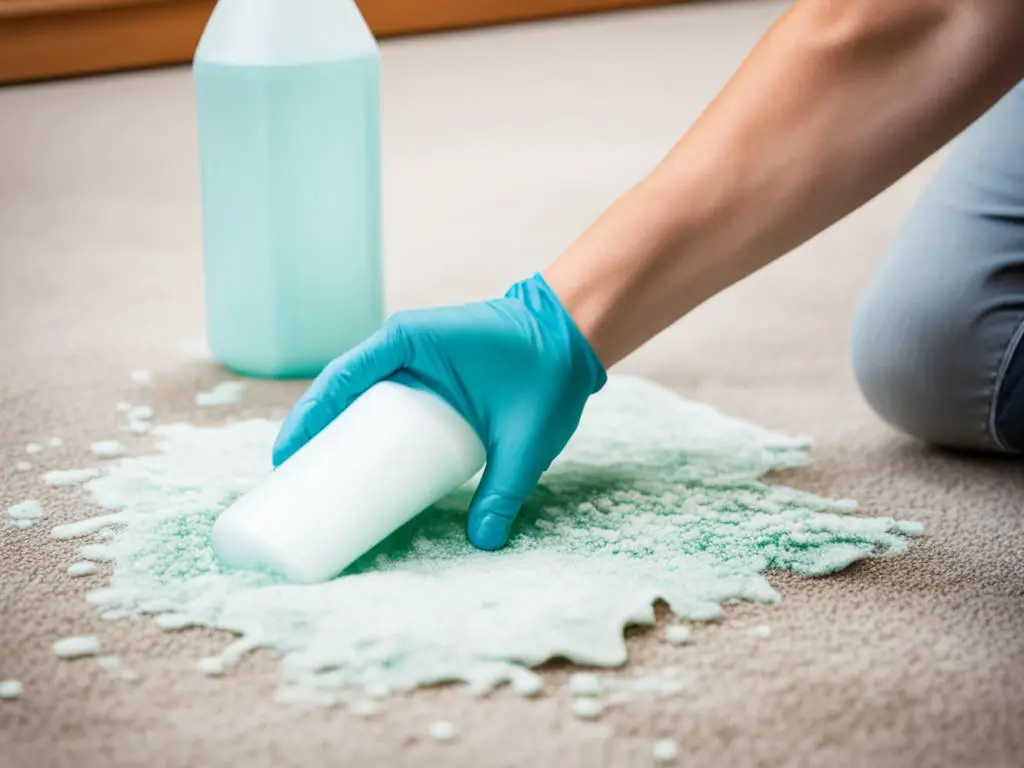
Using Organic Cleaners for Milk Stains
When it comes to removing milk stains from your carpet, using organic cleaners is a safe and eco-friendly option. Many commercial carpet cleaners contain chemicals that can be harmful to both your health and the environment. By opting for organic cleaners, you can effectively remove milk stains while minimizing your impact on the planet.
Organic cleaners are formulated using natural ingredients that are safe for both pets and carpets. They are free from harsh chemicals, synthetic fragrances, and dyes, making them a healthier choice for your family. These cleaners not only remove stains but also eliminate unpleasant odors caused by spoiled milk.
You can find ready-made organic cleaners at your local stores, or you can make your own using simple natural ingredients. Here’s a DIY recipe for an organic cleaner:
- Mix equal parts vinegar and water in a spray bottle.
- Add a tablespoon of baking soda to the mixture and shake well.
- Spray the solution directly onto the milk stain.
- Gently scrub the stain with a soft brush or cloth.
- Wipe up the cleaner and residue with a clean, white towel.
Organic cleaners work by breaking down the proteins in milk stains, making them easier to remove. The vinegar helps neutralize any remaining odors, leaving your carpet fresh and clean.
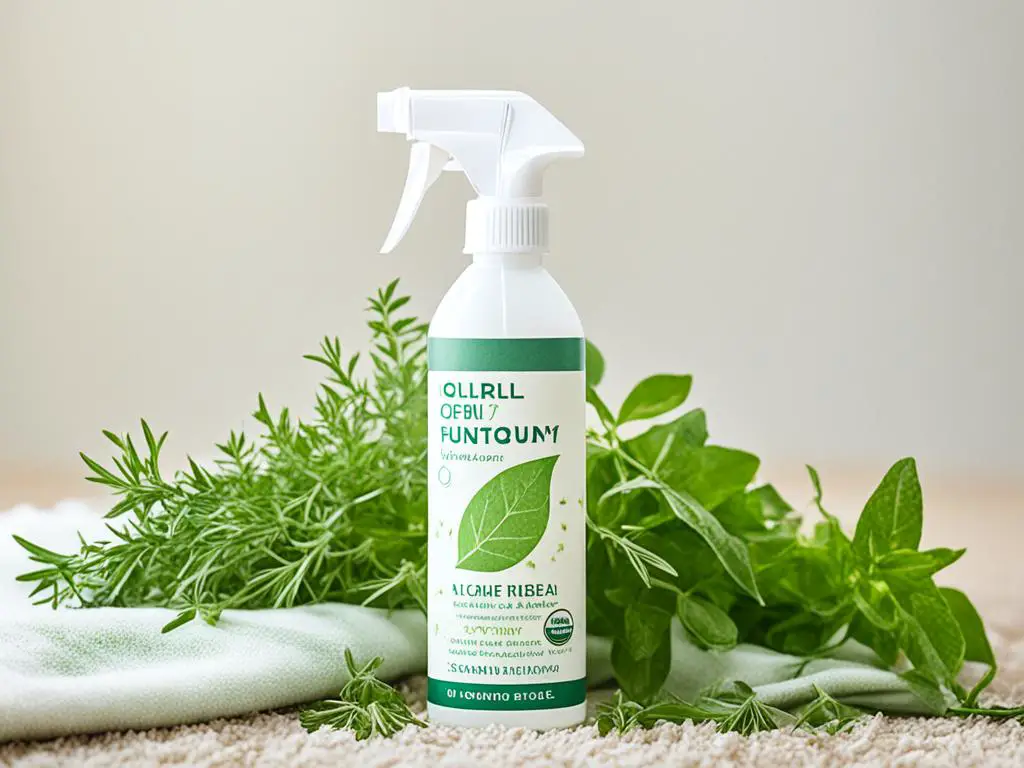
In addition to using organic cleaners, it’s important to follow proper cleaning techniques when treating milk stains. Always blot the stain first to remove excess liquid before applying any cleaners. Avoid scrubbing vigorously, as this can push the milk deeper into the carpet fibers.
Remember, prevention is key when it comes to milk stains. If possible, restrict eating and drinking to designated areas to minimize the risk of spills. However, accidents can happen, and when they do, organic cleaners are a reliable and environmentally friendly solution for milk stain removal.
Benefits of Using Organic Cleaners
Choosing organic cleaners for milk stains offers several advantages:
- Eco-friendly: Organic cleaners are made from natural ingredients, reducing your carbon footprint compared to commercial cleaners.
- Safe for your health: Organic cleaners are free from harmful chemicals that can cause skin irritation or respiratory issues.
- Effective stain removal: Organic cleaners are specially formulated to break down milk stains, ensuring thorough removal.
- Eliminates odors: The natural ingredients in organic cleaners help neutralize sour milk odors, leaving your carpet smelling fresh.
| Brand | Key Features | Price |
|---|---|---|
| GreenClean | Plant-based formula, non-toxic, biodegradable | $12.99 |
| NaturalChoice | Organic ingredients, pet-friendly, no harsh chemicals | $9.99 |
| EcoFresh | Powerful stain remover, environmentally friendly | $14.99 |
Table: Top Organic Cleaners for Milk Stains
By using organic cleaners for milk stains, you can effectively remove stains and odors from your carpet while making a positive impact on the environment. Whether you choose a ready-made cleaner or make your own, you’ll enjoy a cleaner, healthier home with minimal impact on your health and the planet.
Tips for Cleaning Milk Stains from Carpet
To effectively clean milk stains from your carpet, it’s important to act quickly and use the right techniques. Follow these tips to ensure successful milk stain removal and eliminate any sour milk odor.
1. Blot the Stain
Start by removing any excess milk by blotting the stain with a paper towel or absorbent cloth. Gently press the cloth or towel onto the stain to soak up as much liquid as possible. Avoid rubbing the stain, as this can spread it further into the carpet fibers.
2. Scrape off Residue
If the milk spill has dried, gently scrape off any residue using a spoon or blunt knife. Be careful not to damage the carpet fibers. Once the residue is removed, vacuum the area to remove any loose particles.
3. Choose a Cleaning Solution
Next, prepare a cleaning solution to tackle the milk stain. You can create a mixture of cold water and dish soap or use ammonia diluted in water. Both options are effective, so choose the one that suits you best.
4. Apply and Blot
Apply the cleaning solution to the stain and gently blot it with a sponge or cloth. Start from the outer edge of the stain and work your way towards the center. This helps prevent the stain from spreading. Blot the stain repeatedly until it fades away.
5. Rinse and Dry
After removing the stain, rinse the area with cold water to remove any residue from the cleaning solution. Blot the area with a clean cloth or towel to absorb excess moisture. Allow the carpet to air dry completely before using it again.
6. Eliminate Odor with Baking Soda
To eliminate any sour milk odor, sprinkle baking soda over the affected area. Let it sit overnight to absorb the odor. The next day, vacuum the carpet to remove the baking soda, leaving your carpet fresh and odor-free.
Techniques for Removing Milk Stains and Odor
When it comes to removing milk stains and odor from your carpet, there are several techniques you can try. Here are some effective carpet cleaning methods and tips for getting rid of that sour milk smell.
Method 1: Lukewarm Water and Dish Soap
Start by creating a mixture of lukewarm water and dish soap. Apply the solution to the milk stain and gently rub it in a circular motion. This will help break down the stain and lift it from the carpet fibers. Afterward, rinse the area with clean water and blot it dry using a clean cloth or paper towel. This method is particularly effective for fresh milk stains.
Method 2: Ammonia Solution
If the milk stain is stubborn and doesn’t come off with the previous method, you can try using an ammonia solution. Dilute ammonia in lukewarm water and apply it to the stain. Blot the stain with a clean sponge, working from the outer edge towards the center. Be careful when using ammonia as it can have a strong smell, so make sure the area is well-ventilated. Rinse the area with cold water and blot it dry.
Pro Tip: Test the cleaning solution on an inconspicuous area of your carpet before applying it to the milk stain to ensure it doesn’t cause any discoloration or damage.
Getting Rid of Sour Milk Smell
Even after removing the milk stain, you may still be left with a lingering sour milk smell. To eliminate the odor, sprinkle baking soda generously over the affected area. Baking soda is known for its odor-neutralizing properties. Leave the baking soda on the carpet overnight to absorb the sour smell. The next day, simply vacuum up the baking soda, and your carpet should smell fresh and clean.
By using these milk stain removal methods and effective carpet cleaning techniques, you can successfully remove both stains and odors caused by milk spills. Remember to act quickly, and don’t forget to test any cleaning solutions on a small, inconspicuous area first.
Conclusion
Removing milk stains from your carpet can be a daunting task, but by acting quickly and using the right techniques, you can effectively eliminate the stains and keep your carpet looking fresh. When a milk spill occurs, start by blotting the spill and removing any residue or dried milk. This will help prevent further staining and odor development.
Next, wash the stained area with a cleaning solution made of cold water and dish soap or an organic carpet cleaner. Work the solution from the outer edge of the spill towards the center, using a clean cloth or sponge. Rinse the area thoroughly with cold water and blot it dry with a clean towel.
To tackle the sour milk odor that may linger, sprinkle baking soda generously on the affected area. Leave the baking soda to sit overnight, allowing it to absorb the odor. The next day, vacuum up the baking soda, and you’ll be left with a carpet that not only looks clean but also smells fresh.
By following these simple tips and techniques, you can successfully remove milk stains and eliminate the associated odor from your carpet. Act quickly, use the right cleaning solutions, and don’t forget the power of baking soda. With these methods, you can restore your carpet to its original state and maintain a clean and odor-free home.
